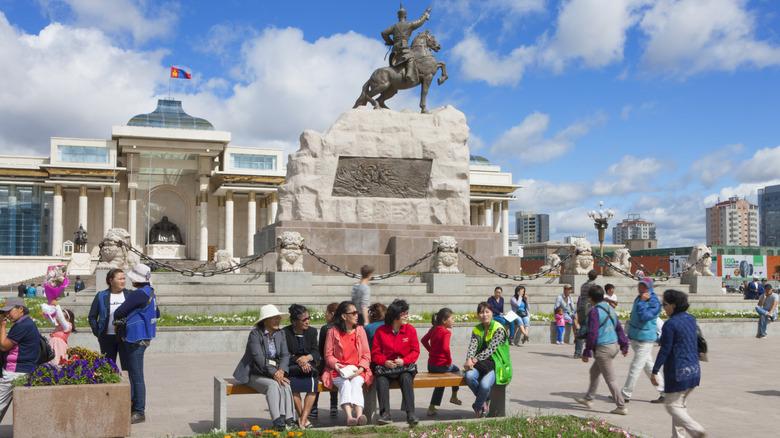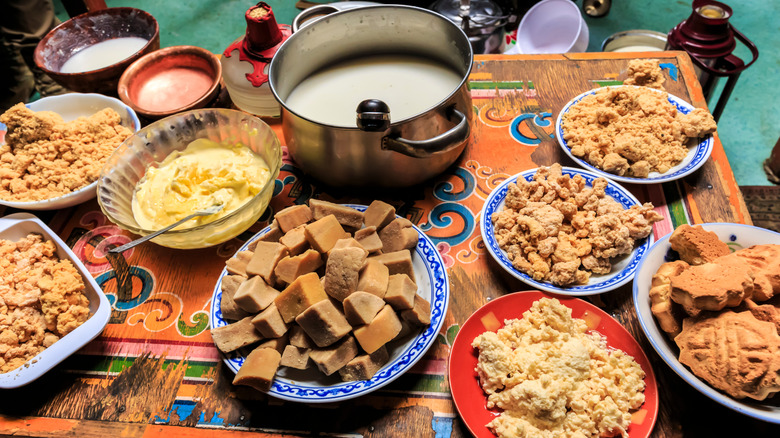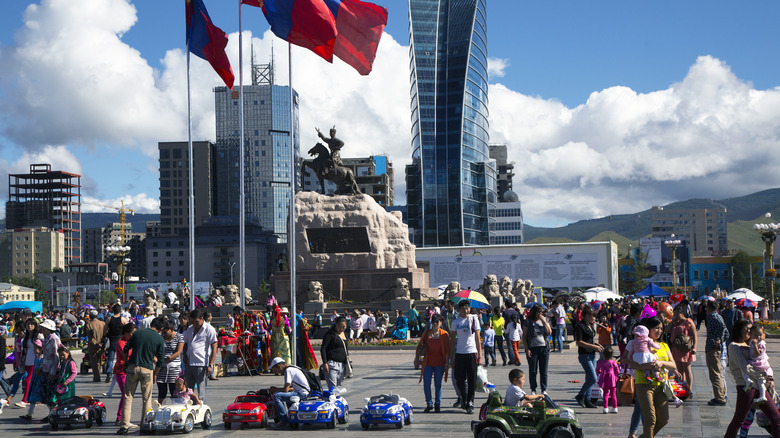The World's Coldest Capital City Is A Foodie Paradise In Asia With Youthful Vibes And Trendy Attractions
You'd probably think that few people would want to live in a city that averages about 3 degrees Fahrenheit during the day (-14 at night) for months of the year. This is the case in most parts of the world, but not in the world's coldest capital city, Ulaanbaatar, Mongolia. Often written as Ulan Bator and called UB by locals, Ulaanbaatar has transformed into a boomtown on the Tuul River and is home to nearly half of Mongolia's population of 3.5 million. Unofficially, though, the city's population is likely greater, as many nomads from the countryside have recently moved to the city's outskirts.
The city is bursting with a youthful energy and some of the biggest worldwide food trends, creating a vibrant restaurant scene. A few decades ago, these scenes of foreign foods and private enterprise would have been almost unimaginable. Around 100 years ago, the new Soviet Union tremendously influenced Mongolia's development as a nation, helping Mongolia remove Chinese influence and establishing a Sovie-oriented Mongolian People's Republic in 1924. In light of a turn toward the USSR, Mongolia renamed its capital city Ulaanbaatar, meaning "red hero," and later adopted the Cyrillic alphabet. Although Mongolia's political climate changed in the 1980s, the country remained politically isolated and economically dependent on the USSR until the Soviet Union fell. In the past 30 years, Mongolia has become a democratic country and opened up to the world. Tourism is growing rapidly, but don't worry, you still have plenty of room to explore Mongolia's uncrowded and underrated natural wonders.
Eat the world in a few blocks in Ulaanbaatar
Mongolian diets traditionally consist of livestock and animal products from the "Five Snouts," which change depending on the local geography and the season. During the warmer months, Mongolians consume white dairy and milk products, while in winter, hearty red meat dishes dominate the menu. Although the most authentic way to try local food is in the countryside with, in my experience, a truly hospitable host family, local restaurants such as Modern Nomads and Khaan Buuz, and machine-processed dairy products mean that traditional foods are available year-round in UB. Traditional Mongolian milk beverages suutei tsai (milk tea) and airag (mare's milk) are considerably more sour than cow's milk and are often enjoyed communally. Trying them will endear you to locals, but take it slow.
In Ulaanbaatar, you sadly won't find a Big Mac. However, the city boasts an incredible variety of international cuisines with a local flair, including tasty coffee, sashimi, and even tacos. Millie's Espresso has been open for over 20 years, and per Google Maps and local experts, it has a killer breakfast. Right next door, La Rosa's killer tapas are just waiting for you to post as you crack open your favorite board game or a beer.
Despite Mongolia's cuisine being quite different than India's, the most vegetarian-friendly country in the world, Ulaanbaatar does have vegetarian and vegan restaurants. The Loving Hut serves vegan versions of traditional and foreign cuisines across the city, along with picture menus. In other restaurants, dishes such as buuz and tsuivan can be served without meat, though the staff may try to replace the meat with another ingredient, such as mushrooms.
How the youth drive UB's culture
Although Mongolia's culture keeps a high regard and respect for traditions and heritage, especially its music, the country's youth continually push the envelope to express themselves and expand opportunities for travel and business. Pop culture, especially Korean culture, has permeated the country along with Korean supermarkets and convenience stores, adding a dash of convenience and cool. Though Ulaanbaatar does not formally have an arts district, the city has tremendous Soviet murals and art museums throughout. The Zanabazar Museum of Fine Arts, the city's first European-style building back in 1905, houses an incredible collection of ornate religious paintings, tapestries, and depictions of the past. On Zaisan Hill south of the city, you'll find one of the best places to watch the sun rise or set, along with a Soviet depiction of the brotherhood formed between Mongolia and the USSR decades ago. Ulaanbaatar also has a burgeoning live music scene, with both hip-hop and rock being symbols of a free, post-Communist Mongolia.
Mongolia is still very much the Wild West and far off the beaten path for many travelers, though that may be about to change. United is adding routes from Tokyo Narita to Ulaanbaatar starting May 1, 2025, and is modernizing its aircraft fleet to include creature comforts. Moreover, Mongolia is visa-free for many nationalities, including the U.S., Canada, the U.K., and much of Europe, though many other nationalities can apply for an eVisa. In my experience, downloading a free local phrasebook or language course is a must-do if you want to meet locals on your trip.


